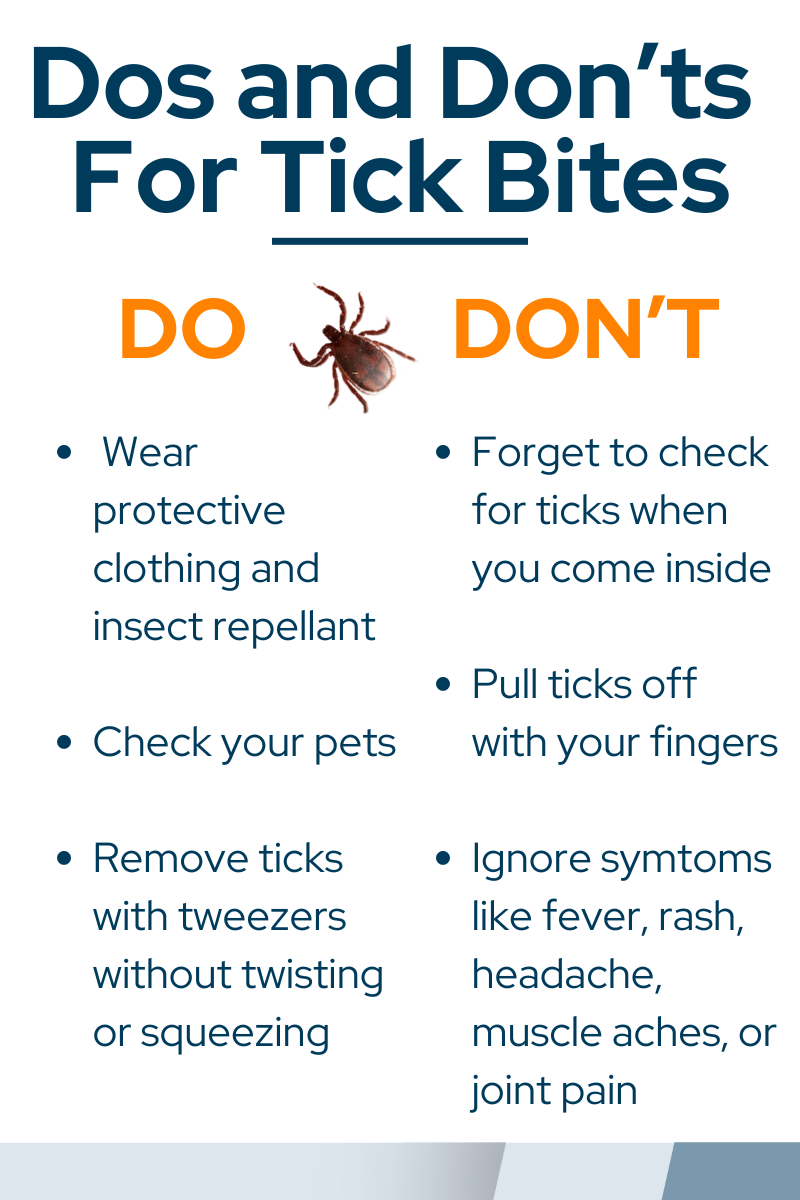Published: June 17, 2024
Your Dos and Don’ts for Tick Season
By: Dr. Valerie Danielson, Elliot Family Medicine at Bedford
Tick bites might seem minor, but they can pose serious health risks if not handled properly. With the potential for transmitting diseases like Lyme disease and Rocky Mountain spotted fever, it's important to be aware of the dangers, understand prevention strategies, and know when to seek help. In this post, we'll explore the ins and outs of tick bites, from prevention to response.
The Dangers of Tick Bites
Ticks are small arachnids that feed on the blood of animals and humans. While not all tick bites result in illness, some ticks carry disease-causing pathogens that can be transmitted to their hosts during feeding. The primary dangers associated with tick bites include:
- Lyme Disease: Caused by the bacterium Borrelia burgdorferi, Lyme disease can lead to symptoms such as fever, fatigue, joint pain, and a characteristic bull's-eye rash. If left untreated, it can cause serious complications affecting the joints, heart, and nervous system.
- Rocky Mountain Spotted Fever: Transmitted by several different species of ticks, including the American dog tick, Rocky Mountain spotted fever can cause fever, headache, rash, and, in severe cases, organ failure. Early detection and treatment are essential to prevent complications.
- Other Tick-Borne Diseases: Ticks can also transmit a variety of other diseases, including ehrlichiosis, anaplasmosis, babesiosis, and tularemia, depending on the species.

Prevention of Tick Bites
Preventing tick bites is key to avoiding tick-borne illnesses. Steps you can take to reduce your risk of encountering ticks and getting bitten include:
- Use Insect Repellent: Apply an EPA-registered insect repellent containing DEET, picaridin, or permethrin to exposed skin and clothing when outdoors.
- Wear Protective Clothing: Wear long-sleeved shirts, long pants, and closed-toe shoes when walking in wooded or grassy areas. Tuck pant legs into socks or boots to prevent ticks from crawling up your legs.
- Stay on Trails: Stick to cleared paths and trails when hiking or spending time outdoors, and avoid walking through tall grass or dense vegetation where ticks may be prevalent.
- Perform Tick Checks: After spending time outdoors, thoroughly check your body and clothing for ticks. Pay close attention to areas such as the scalp, armpits, groin, and behind the ears. Use the buddy system to check hard-to-see areas such as the scalp and back.
- Shower After Outdoor Activities: Showering within two hours of being outdoors can help wash away any ticks that may be crawling on your skin but haven't attached yet.
- Check Pets: Carefully check your pets when they come indoors. Ticks may be harmful to them and may be transferred to people and other pets.
When to Seek Help for a Tick Bite
If you've been bitten by a tick or suspect you may have been, it's essential to know when to seek medical attention:
- Tick Removal: Remove the tick promptly using fine-tipped tweezers. Grasp the tick as close to the skin's surface as possible and pull upward with steady, even pressure. Avoid squeezing the tick’s body, twisting, or jerking, as this can cause contamination or the mouthparts to break off and remain in the skin.
- Symptoms: Monitor yourself for symptoms of tick-borne illnesses, especially if you develop a fever, rash, headache, muscle aches, or joint pain within a few weeks of a tick bite.
- Seek Medical Attention: If you develop symptoms or are unsure whether the tick was attached for an extended period, consult your primary care provider. They can provide guidance on testing, treatment, and monitoring for potential complications.
Tick bites may be common, but they shouldn't be taken lightly. By understanding the dangers, implementing preventive measures, and knowing when to seek help, you can reduce your risk of tick-borne illnesses and enjoy the great outdoors safely. Remember to stay vigilant, perform regular tick checks, and seek medical attention if needed. Stay safe out there!
 Valerie J Danielson, MD, FAAFP, DABOM is a family medicine practitioner at Elliot Family Medicine at Bedford.
Valerie J Danielson, MD, FAAFP, DABOM is a family medicine practitioner at Elliot Family Medicine at Bedford.
